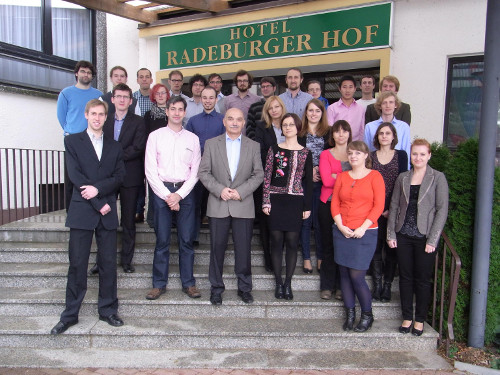
On December 3rd and 4th, 2012, the team "Nano Analysis for Energy Technology" (ENano), an ESF founded young researchers group, from the Institute for Materials Science of Technical University Dresden organized a joint PhD seminar with students from the Institute of Metallurgy and Materials Science of the Polish Academy of Sciences, Krakow.During the meeting, all 23 young scientists presented their new original results in scientific talks. Exciting examples were the visualization of inner potentials in solar cells by electron holography, the reinforcement of aluminium matrix nano composites by AlN particles and the resurrection of the steam/iron process for hydrogen storage. On December 5th and 6th both groups attended the first international Executive Course organized by German Society of Materials Science (DGM) with support of the Federation of European Material Societies (FEMS) and in collaboration with the Dresden Fraunhofer Cluster Nanoanalysis (DFCNA). 13 experts from academia and industry gave lectures focused on the topic "Nano-scale Materials and Advanced Characterization Techniques". Highlights were a guest presentation by Professor Dr. Velimir RadmiloviÄ from the University of Belgrade, a world-leading expert in electron microscopy who spent most of his scientific career at the Berkeley National Lab, and an invited talk by Dr. Hans-Jürgen Engelmann, Manager of the Analytics Center at GLOBALFOUNDRIES Dresden.
Giovanni Cuniberti, professor at the Institute for Materials Science of the Technical University Dresden and Pawel ZiÄba, director of the Institute of Metallurgy and Materials Science of the Polish Academy of Sciences in Krakow opened the session on Monday by introducing their cities and institutes. A broad range of topics from nano-scale analytical methods for various energy technologies to mechanical properties of different alloys for aerospace engineering and other applications as well as improvements for solar panels and biotech was presented in two days. The ENano researchers and the young polish scientists used the opportunity to discuss their results during the workshop and in informal discussions. This led to several new ideas for upcoming experiments, like the combination of two microscopic methods, and the evaluation of current results of their own work.
Ehrenfried Zschech, speaker of the Dresden Fraunhofer Cluster Nanoanalysis, opened the DGM seminar on Wednesday with an overview of the broad range of high-resolution analytical techniques for characterization of nano-scale materials and structures, before the experts presented their field of analytical techniques and applications in detail. The first session on Wednesday was hosted by the Fraunhofer IZFP, while the second one on Thursday took place in the Fraunhofer IKTS. The young scientists had the opportunity to attend a lab tours and to see the equipment at both research facilities. To discuss their topics in a more informal ambience the research groups met for a joint dinner on Monday and Wednesday.

On December 3rd and 4th, 2012, the team "Nano Analysis for Energy Technology" (ENano), an ESF founded young researchers group, from the Institute for Materials Science of Technical University Dresden organized a joint PhD seminar with students from the Institute of Metallurgy and Materials Science of the Polish Academy of Sciences, Krakow.During the meeting, all 23 young scientists presented their new original results in scientific talks. Exciting examples were the visualization of inner potentials in solar cells by electron holography, the reinforcement of aluminium matrix nano composites by AlN particles and the resurrection of the steam/iron process for hydrogen storage. On December 5th and 6th both groups attended the first international Executive Course organized by German Society of Materials Science (DGM) with support of the Federation of European Material Societies (FEMS) and in collaboration with the Dresden Fraunhofer Cluster Nanoanalysis (DFCNA). 13 experts from academia and industry gave lectures focused on the topic "Nano-scale Materials and Advanced Characterization Techniques". Highlights were a guest presentation by Professor Dr. Velimir RadmiloviÄ from the University of Belgrade, a world-leading expert in electron microscopy who spent most of his scientific career at the Berkeley National Lab, and an invited talk by Dr. Hans-Jürgen Engelmann, Manager of the Analytics Center at GLOBALFOUNDRIES Dresden.
Giovanni Cuniberti, professor at the Institute for Materials Science of the Technical University Dresden and Pawel ZiÄba, director of the Institute of Metallurgy and Materials Science of the Polish Academy of Sciences in Krakow opened the session on Monday by introducing their cities and institutes. A broad range of topics from nano-scale analytical methods for various energy technologies to mechanical properties of different alloys for aerospace engineering and other applications as well as improvements for solar panels and biotech was presented in two days. The ENano researchers and the young polish scientists used the opportunity to discuss their results during the workshop and in informal discussions. This led to several new ideas for upcoming experiments, like the combination of two microscopic methods, and the evaluation of current results of their own work.
Ehrenfried Zschech, speaker of the Dresden Fraunhofer Cluster Nanoanalysis, opened the DGM seminar on Wednesday with an overview of the broad range of high-resolution analytical techniques for characterization of nano-scale materials and structures, before the experts presented their field of analytical techniques and applications in detail. The first session on Wednesday was hosted by the Fraunhofer IZFP, while the second one on Thursday took place in the Fraunhofer IKTS. The young scientists had the opportunity to attend a lab tours and to see the equipment at both research facilities. To discuss their topics in a more informal ambience the research groups met for a joint dinner on Monday and Wednesday.